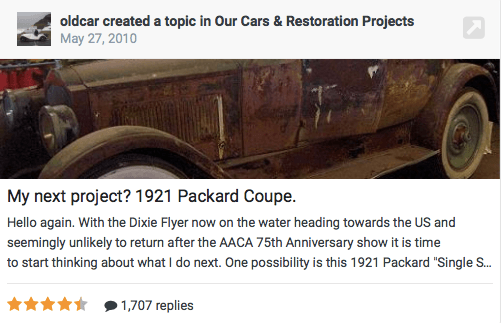You must be logged in to rate content!
5 minute(s) of a 173 minute read
9-8-2017
Hello Paul
Thank you. There certainly appears to be a lot of "stuff" there; much of it I would not want or need. I would much sooner persevere with the original bits that I have. I have a couple of problems. It is all in New Zealand and every time in the past I have bought anything from NZ I have ended up with a lot of useless rubbish. i.e a six cylinder 1929 Renault engine that turned out to be a collection of loosely assorted bits, including just five and a half con-rods for a six cylinder engine. AND I was silly enough to pay for air freight for it.
So far, I am not really needing any parts. I do not really want to use a 1924 Cast iron cylinder head engine if I can avoid it.
Hello Scott
After a lifetime involved with old cars I still find it fascinating how some makes of car attract people who are ready to assist total strangers while others simply do not want to know. It is not where they live our how rich or poor they are. Perhaps it has something to do with a willingness to pick up a spanner and to get their hands dirty. That and the willingness to help a comparative stranger.
It seems that I have devoted a large part of my life rescuing “Lost Causes and Basket case" motor cars. The one car I have owned longer than anything else in my 1934 Lagonda Rapier. I have owned it since 1978 and together with my wife, Helen, we have covered over 100,000 miles in it. It has travelled to the UK & Europe with us no less than 5 times and we have visited in addition to the UK, France - Spain - Italy - Germany - Belgium and Holland, using it as a daily driver during the time we are away. I have a long list, in height order, of the Alpine passes we have climbed in it. My Profile photograph is one Helen took at the summit of the highest road pass in France. The Col d'Ilseran 2769 metres.
I am very aware that I along with the other owners of Lagonda Rapiers I am spoilt. The entire production of Rapiers between 1934 and 38 was less than 400 cars. Added to this is the fact that the Lagonda Factory never built any bodies on Rapier Chassis relying on various coach-building firms to supply the bodies of the customers choice. Today the UK based Rapier Register's (Club) Spares carries a full stock of new mechanical parts (for an 80 year old limited production car) run by an enthusiastic group of members on a voluntary basis. There is virtually no mechanical part that I cannot buy new and have it delivered from the UK to Australia within two weeks.
By contrast I have recently bought and sold within a month a 1924 Amilcar because despite joining the relevant owners club, I was told that I would not be able to buy spares through the club despite becoming a paid up member, because I would possibly sell the car again having restored it.
I experienced a similar thing some years back with a 1922 Packard Single Six with a well known Dealer in the US suggesting that people should not buy the car because it was, in his terms, a "Mongrel” without him having ever seen the car. I offered to re-imburse the cost of an return airfare from anywhere in the world to Australia to anyone who could come and point out any part that was not on the car when it left the factory. Nobody came to take up my offer!
It had been a Doctor’s Coupe. It had been exported from USA to Australia some 30 years earlier as a “Parts Car”. Following a dispute with the Australian Customs over the amount of Duty to be paid it had been abandoned on the Docks in Melbourne. To save space in the container it had the roof cut off around the waist line and thrown away along with the original seats and much of the trim. I bought it from a person who had bought it 30 years later. He had a contract to do steam cleaning with the Australian Customs Service and saw it standing in a shed on the waterfront.
I rebuilt the car as a convertible, look at :

Please tell me what terrible sin I had committed. Yet not one of the local Melbourne based Packard Club members showed any interest in or even looked at the car.
I am sorry but now being almost 81, I am not going to embark on a restoration of the Studebaker to the magnitude of that I may have done even ten years earlier.
It will be what the British refer to as an "Oily Rag Restoration".
The Dixie Flyer referred to above is now in Louisville Kentucky with the family who today run the Company that originally built Dixie Flyers 1917 -1923. Now, The Kentucky Trailer Co.